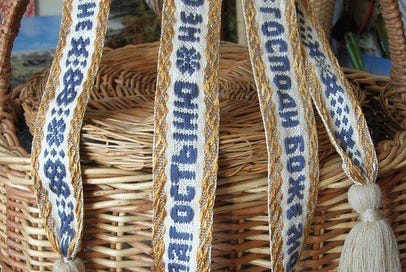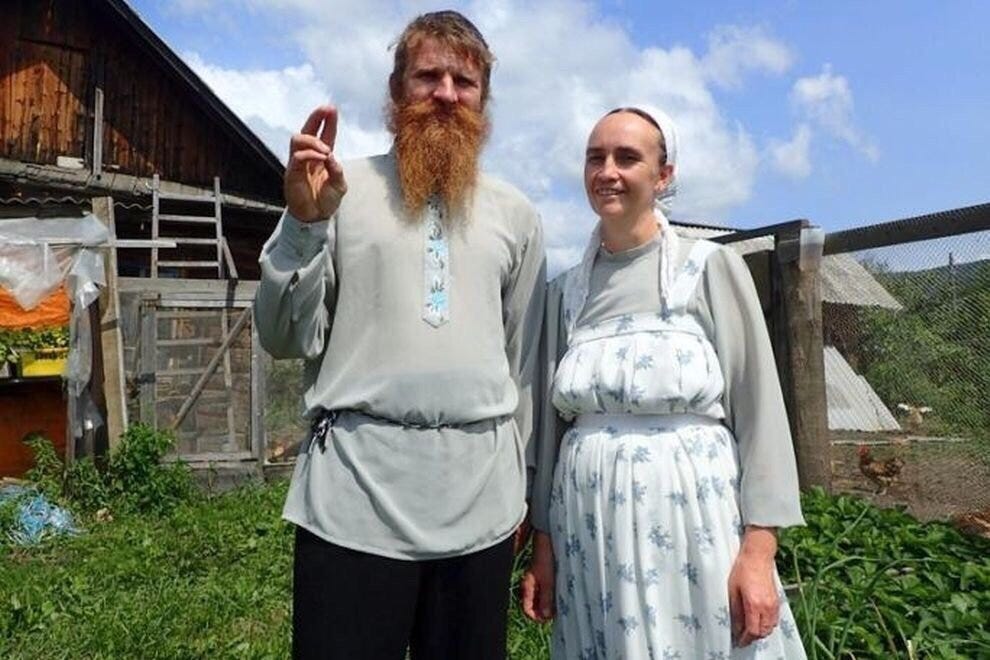The belt was a mandatory element of both women's and men's Russian folk clothing. It appeared during the pagan era and primarily had a utilitarian value: belted clothing is significantly warmer since it fits more snugly to the body and is also more convenient during work. Moreover, weapons (a knife in a sheath, etc.), work tools (an axe), and various items (a purse for money, a comb, keys, flint) were attached to or behind the belt. In pre-Christian times, the belt also had a ritual significance: various kinds of signs were depicted on it, protecting the person from the influence of evil forces. The belt indicated the social status of the owner: there were princely, warrior, familial belts, etc. It should be noted that the social characteristic of the belt persisted for many centuries, and, for example, in the spiritual charters (wills) of the grand princes, among the treasures, gold belts were listed (Ivan Kalita had nine; Dmitry Donskoy - eight), meaning the sons of the grand princes inherited not only land but also gold belts. By the belt, one could even tell the marital status, for example, belts of young men were longer than those of married men. In ancient Russian costume, two, sometimes three belts were used (a body belt and belts worn over each type of clothing).
Belts were made differently: they were braided, woven, twisted from threads. The materials were wool, flax, hemp, bast, later cotton, silk, gold, and silver threads. Princely belts, which can be seen in museums, were embroidered with silk, gold, and silver threads, and decorated with precious stones. The length of the belt could be from one and a half meters to 4 and even 5-6 meters, which was related to the specifics of tying the belt: it could be wrapped around the waist several times. The belt was tied with a knot at the front or side so that its ends hung down by 20-40 cm. Belts varied in width. The body belt was narrow and simple, unadorned, worn on the bare body (hence its name - body belt). It wore out quickly and was replaced by another, just as simple. The everyday shirt was belted, usually with a thin belt (2 cm), the festive one - with a colorful belt (from 4-5 cm to 8-9 cm).
In Russia, after the adoption of Christianity, the belt, along with the cross, was a sign of belonging to the Orthodox world. It represents a kind of symbol of being dressed, that is, without a belt, as well as without a body cross (and for women - also without a scarf), a person, one might say, was excluded from the social and cultural-religious environment. The absence of a belt was a sign of belonging to another, alien world, including ethnic and confessional. A person without a belt, like without a cross, is vulnerable, he opens access to himself to unclean powers. It was not customary for Russians to be without a belt not only outside the home but also at home. Moreover, it was considered indecent, hence the verb "to unbelt" acquired the figurative meaning "to become dissolute, undisciplined, to lose all restraint; to behave provocatively, loosely". Also, for Russians, it was offensive if a belt was torn off a person, it meant - to dishonor him. It should be noted that in some Old Believer parishes, even now, a person without a belt may not be allowed into the service or may be strictly admonished.
The belt was a mandatory part of clothing for Russians, both for everyday and festive attire, even at the beginning of the 20th century, but it gradually fell out of everyday use, remaining only among Old Believers, and even then, as a part of the Russian costume worn for church services. However, Old Believers of the chapel consent, mainly living in South America, have preserved the wearing of belts not only for church services but also in everyday life.
"Let your loins be girded about, and your lights burning; And ye yourselves like unto men that wait for their lord, when he will return from the wedding; that when he cometh and knocketh, they may open unto him immediately" (Luke 12:35,36).
Symbolic meaning of the belt:
Chastity, temperance, and self-restraint - these pious qualities are symbolized by the belt, which every baptized person should wear.
Christians have always attributed a symbolic meaning to the belt as a grace-filled power, strengthening them in the fight against invisible enemies:
"Stand therefore, having your loins girt about with truth, and having on the breastplate of righteousness; And your feet shod with the preparation of the gospel of peace; Above all, taking the shield of faith, wherewith ye shall be able to quench all the fiery darts of the wicked. And take the helmet of salvation, and the sword of the Spirit, which is the word of God" (Ephesians 6:14-17).
"Wherefore gird up the loins of your mind, be sober, and hope to the end for the grace that is to be brought unto you at the revelation of Jesus Christ" (1 Peter 1:13).
Saint Basil the Great wrote about Christians wearing the belt:
"The necessity of wearing a belt is demonstrated by the saints who lived before us: John, who girded his loins with a leather belt (Matthew 3:4); and before him Elijah, as the distinction of this man is described: 'A hairy man, and girt with a girdle of leather about his loins' (2 Kings 1:8)."
For Christians, the belt is an object with deep symbolic meaning. It represents both the separation of the "carnal" lower part from the "spiritual" upper part and the readiness to serve God. Without a belt, one should neither pray nor retire to sleep. Hence, there's a widespread expression preserved in modern language: "распоясаться," (literally, “to unbelt” - trans.) meaning "to become loose, unrestrained." In ancient times, it was considered extremely improper to be among people without a belt.





Does the store in Oregon also weave belts?
I've found several stores which sell traditional Kaftan, kosovorotka, and thus. Trousers and shoes are rather universal. However I've found no place that sells belts.
One more link to a Facebook seller in Romania I forgot about...
https://www.facebook.com/broderii.claudia